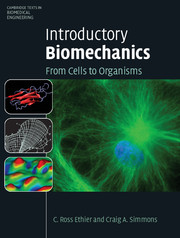Book contents
- Frontmatter
- Contents
- About the cover
- Preface
- 1 Introduction
- 2 Cellular biomechanics
- 3 Hemodynamics
- 4 The circulatory system
- 5 The interstitium
- 6 Ocular biomechanics
- 7 The respiratory system
- 8 Muscles and movement
- 9 Skeletal biomechanics
- 10 Terrestrial locomotion
- Appendix: The electrocardiogram
- Index
- Plate section
- References
2 - Cellular biomechanics
Published online by Cambridge University Press: 05 June 2012
- Frontmatter
- Contents
- About the cover
- Preface
- 1 Introduction
- 2 Cellular biomechanics
- 3 Hemodynamics
- 4 The circulatory system
- 5 The interstitium
- 6 Ocular biomechanics
- 7 The respiratory system
- 8 Muscles and movement
- 9 Skeletal biomechanics
- 10 Terrestrial locomotion
- Appendix: The electrocardiogram
- Index
- Plate section
- References
Summary
The cell is the building block of higher organisms. Individual cells themselves are highly complex living entities. There are two general cell types: eukaryotic cells, found in higher organisms such as mammals, and prokaryotic cells, such as bacteria. In this chapter, we will examine the biomechanics of eukaryotic cells only. We will begin by briefly reviewing some of the key components of a eukaryotic cell. Readers unfamiliar with this material may wish to do some background reading (e.g., from Alberts et al. [1] or Lodish et al. [2]).
Introduction to eukaryotic cellular architecture
Eukaryotic cells contain a number of specialized subsystems, or organelles, that cooperate to allow the cell to function. Here is a partial list of these subsystems.
Walls (the membranes). These barriers are primarily made up of lipids in a bilayer arrangement, augmented by specialized proteins. They serve to enclose the cell, the nucleus, and individual organelles (with the exception of the cytoskeleton, which is distributed throughout the cell). The function of membranes is to create compartments whose internal materials can be segregated from their surroundings. For example, the cell membrane allows the cell's interior to remain at optimum levels of pH, ionic conditions, etc., despite variations in the environment outside the cell. The importance of the cell membrane is shown by the fact that cell death almost invariably ensues if the cell membrane is ruptured to allow extracellular materials into the cell.
[…]
- Type
- Chapter
- Information
- Introductory BiomechanicsFrom Cells to Organisms, pp. 18 - 118Publisher: Cambridge University PressPrint publication year: 2007
References
- 1
- Cited by



